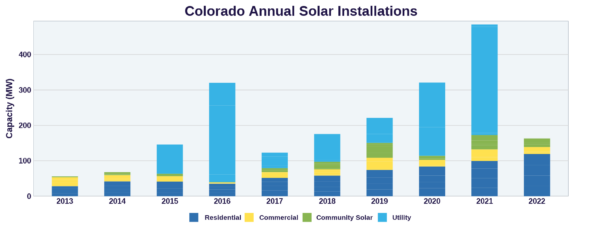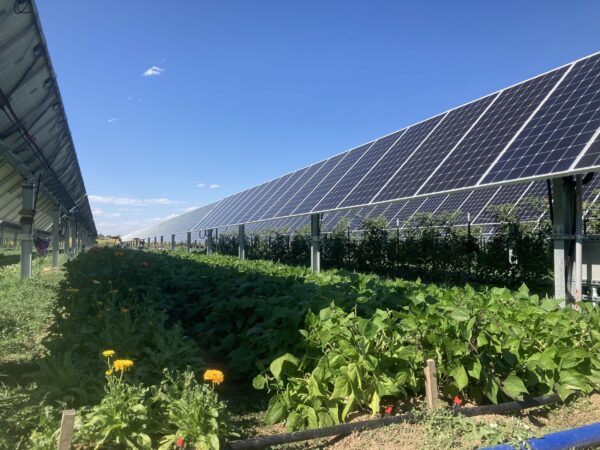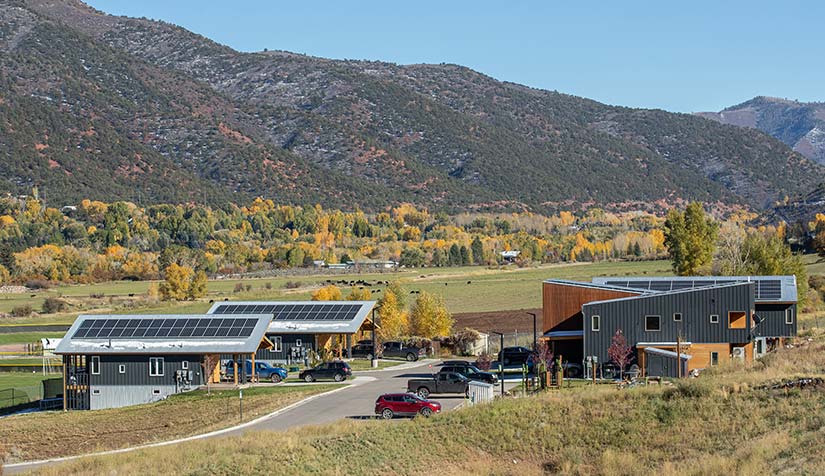Colorado had installed about 2.3 GW of solar capacity through the end of 2022, enough to power the equivalent of over 450,000 homes, said the Solar Energy Industries Association (SEIA). SEIA expects the state to more than double its capacity over the next five years, adding 3.2 GW along the way.
The Rocky Mountain State is home to nearly 400 solar companies, employing over 7,000 people. It also is the site of the National Renewable Energy Laboratory (NREL) in Golden.
Over 6.3% of the state’s electricity generation comes from solar, higher than the national average. Colorado has over 300 sunny days per year and was among the first states to enact a renewable energy standard.

Incentives
Colorado was an early adopter of solar incentives, which may explain in part why it has the 13th most solar capacity among the states despite being the 21st most populated state.
Residential solar customers are offered net metering, a program in which excess solar production is exported to the grid during the day and is credited for nighttime usage. The state’s largest utility, Xcel Energy, offers net metering for all projects 1 MW and smaller. Net metering helps secure a desirable return on investment for solar arrays, even when not paired with energy storage.
Colorado also places tax exemptions on solar. There is no sales tax when purchasing a system, and it is property tax exempt, meaning that even though it will increase the value of your home, it will not increase your property taxes.
Xcel Energy has a solar rewards program, under the program, you agree to sell renewable energy credits (RECs) to the utility in exchange for cash payments. RECs are intangible assets created by the generation of clean electricity. By agreeing to sell 20 years of RECs, Xcel will pay $0.07 per kWh for 10 years for the credits. This equates to a payment of $6,500 over 10 years for a 6 kW system.
Holy Cross Energy offers $500 per kW up to 6 kW, and Energy Smart Colorado supports installations with rebates up to $2500 for Pitkin and Eagle County, Eagle Valley, Vail, and Summit County.
Like all solar installations in the United States, Colorado solar projects are eligible for the federal Investment Tax Credit. The credit covers 30% of installed system costs, and can be rolled over year to year if the customer lacks the tax liability to take advantage of the credit in one tax session.
Colorado also supports a microgrid grant program. Microgrids are a connected series of distributed energy resources like solar, paired with backup battery systems, and often connected with smart appliances and meters. Microgrids are particularly beneficial to communities that are exposed to extreme weather or experience frequent outages. Available to remote communities, the grant program allocates $400,000, with maximum individual rewards of $36,000.
Notable installation
On the edges of Boulder, Colorado sits Jack’s Solar Garden, a community garden that grows crops and local pollinator supporting plants. This community garden is far from ordinary, as it houses a 1.2 MW solar array that shares the same land as the crops below.
Jack’s Solar Garden is the largest commercial agrivoltaics research site in the United States. The 24-acre plot is part of a research study being conducted by the National Renewable Energy Laboratory (NREL), Colorado State University and the University of Arizona to understand the microclimates created by the panels and how they impact vegetation growth.

The electricity generated by the single-axis tracker mounted array is enough to power 300 average Colorado homes annually. The power is sold to various subscribers via utility Xcel Energy’s Solar Rewards Community program, where customers receive a percentage of the net metered production as credits against their monthly electric bills.
Fifty residents, five local businesses, and two local governments subscribe to the plant. Jack’s Solar Garden donates 2% of its power production to low-income households through the Boulder County Housing Authority.
A study by Oregon State University showed wide-scale installation of agrivoltaic systems could lead to an annual reduction of 330,000 tons of carbon dioxide emissions in the U.S. while “minimally” impacting crop yield, the researchers said.
Up next
Last time, we toured the solar incentives of Utah, and next we will move south to the sunny state of Arizona. For a full list the state articles to date, click here.
This content is protected by copyright and may not be reused. If you want to cooperate with us and would like to reuse some of our content, please contact: editors@pv-magazine.com.









By submitting this form you agree to pv magazine using your data for the purposes of publishing your comment.
Your personal data will only be disclosed or otherwise transmitted to third parties for the purposes of spam filtering or if this is necessary for technical maintenance of the website. Any other transfer to third parties will not take place unless this is justified on the basis of applicable data protection regulations or if pv magazine is legally obliged to do so.
You may revoke this consent at any time with effect for the future, in which case your personal data will be deleted immediately. Otherwise, your data will be deleted if pv magazine has processed your request or the purpose of data storage is fulfilled.
Further information on data privacy can be found in our Data Protection Policy.